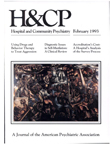Pharmacological and Behavioral Treatments for Aggressive Psychiatric Inpatients
Abstract
Objective: Because aggressive behaviors of psychiatric patients may be caused by environmental or biological factors, treatment plans that incorporate medication and behavior therapies are the most effective. The authors review research on pharmacological and behavioral treatments for aggressive patients and present a decision tree f or use on behavioral units to direct treatment of such patients. Method. The empirical literature was searched for studies of pharmacological and behavioral interventions that have been shown to have some value for treating this problem. Results and conclusions: Psychiatrists must proceed cautiously because no medication has been approved by the Food and Drug Administration specifically for treatment of aggression. Antipsychotics, lithium, antidepressants, sedatives, anxiolytics, anticonvulsants, opiate antagonists, and beta blockers have been used, often depending on the etiology of the aggression, such as head injury or dementia. Although some drugs such as buspirone and propranolol show promise, side effects must be monitored. Three behavioral strategies have effectively reduced aggression in the inpatient milieu. The token economy is perhaps the most comprehensive behavioral tool for producing a well-structured milieu. Aggression replacement strategies help patients learn alternative responses. Decelerative techniques teach strategies that enable the patient to reduce aggression quickly. The authors describe a decision tree to guide decisions about pharmacological and behavioral treatments of aggression depending on where in the course of the disorder patients exhibit difficulty.
Access content
To read the fulltext, please use one of the options below to sign in or purchase access.- Personal login
- Institutional Login
- Sign in via OpenAthens
- Register for access
-
Please login/register if you wish to pair your device and check access availability.
Not a subscriber?
PsychiatryOnline subscription options offer access to the DSM-5 library, books, journals, CME, and patient resources. This all-in-one virtual library provides psychiatrists and mental health professionals with key resources for diagnosis, treatment, research, and professional development.
Need more help? PsychiatryOnline Customer Service may be reached by emailing [email protected] or by calling 800-368-5777 (in the U.S.) or 703-907-7322 (outside the U.S.).



